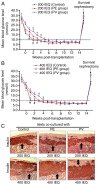VNN1 overexpression in pancreatic cancer cells inhibits paraneoplastic islet function by increasing oxidative stress and inducing β‑cell dedifferentiation
- PMID: 37114564
- PMCID: PMC10173380
- DOI: 10.3892/or.2023.8557
VNN1 overexpression in pancreatic cancer cells inhibits paraneoplastic islet function by increasing oxidative stress and inducing β‑cell dedifferentiation
Abstract
Vanin‑1 (VNN1) may be a potential biomarker for the early screening of pancreatic cancer (PC)‑associated diabetes (PCAD). A previous study by the authors reported that cysteamine secreted by VNN1‑overexpressing PC cells induced the dysfunction of paraneoplastic insulinoma cell lines by increasing oxidative stress. In the present study, it was observed that both cysteamine and exosomes (Exos) secreted by VNN1‑overexpressing PC cells aggravated the dysfunction of mouse primary islets. PC‑derived VNN1 could be transported into islets through PC cell‑derived Exos (PC‑Exos). However, β‑cell dedifferentiation, and not cysteamine‑mediated oxidative stress, was responsible for the islet dysfunction induced by VNN1‑containing Exos. VNN1 inhibited the phosphorylation of AMPK and GAPDH, and prevented Sirt1 activation and FoxO1 deacetylation in islets, which may be responsible for the induction of β‑cell dedifferentiation induced by VNN1‑overexpressing PC‑Exos. Furthermore, it was demonstrated that VNN1‑overexpressing PC cells further impaired the functions of paraneoplastic islets in vivo using diabetic mice with islets transplanted under the kidney capsule. On the whole, the present study demonstrates that PC cells overexpressing VNN1 exacerbate the dysfunction of paraneoplastic islets by inducing oxidative stress and β‑cell dedifferentiation.
Keywords: VNN1; exosomes; oxidative stress; pancreatic cancer‑associated diabetes; β‑cell dedifferentiation.
Conflict of interest statement
The authors declare that they have no competing interests.
Figures







Similar articles
-
VNN1, a potential biomarker for pancreatic cancer-associated new-onset diabetes, aggravates paraneoplastic islet dysfunction by increasing oxidative stress.Cancer Lett. 2016 Apr 10;373(2):241-50. doi: 10.1016/j.canlet.2015.12.031. Epub 2016 Feb 1. Cancer Lett. 2016. PMID: 26845448
-
Vanin1 (VNN1) in chronic diseases: Future directions for targeted therapy.Eur J Pharmacol. 2024 Jan 5;962:176220. doi: 10.1016/j.ejphar.2023.176220. Epub 2023 Dec 1. Eur J Pharmacol. 2024. PMID: 38042463 Review.
-
Paraneoplastic β Cell Dedifferentiation in Nondiabetic Patients with Pancreatic Cancer.J Clin Endocrinol Metab. 2020 Apr 1;105(4):dgz224. doi: 10.1210/clinem/dgz224. J Clin Endocrinol Metab. 2020. PMID: 31781763
-
Glucagon receptor blockage inhibits β-cell dedifferentiation through FoxO1.Am J Physiol Endocrinol Metab. 2023 Jan 1;324(1):E97-E113. doi: 10.1152/ajpendo.00101.2022. Epub 2022 Nov 16. Am J Physiol Endocrinol Metab. 2023. PMID: 36383639
-
Influence of Vanin-1 and Catalytic Products in Liver During Normal and Oxidative Stress Conditions.Curr Med Chem. 2015;22(20):2407-16. doi: 10.2174/092986732220150722124307. Curr Med Chem. 2015. PMID: 26549544 Review.
Cited by
-
Diabetes Mellitus in Pancreatic Cancer: A Distinct Approach to Older Subjects with New-Onset Diabetes Mellitus.Cancers (Basel). 2023 Jul 19;15(14):3669. doi: 10.3390/cancers15143669. Cancers (Basel). 2023. PMID: 37509329 Free PMC article. Review.
-
Targeting early diagnosis and treatment of pancreatic cancer among the diabetic population: a comprehensive review of biomarker screening strategies.Diabetol Metab Syndr. 2025 May 28;17(1):176. doi: 10.1186/s13098-025-01750-4. Diabetol Metab Syndr. 2025. PMID: 40437631 Free PMC article. Review.
-
Glycolipid Metabolic Disorders, Metainflammation, Oxidative Stress, and Cardiovascular Diseases: Unraveling Pathways.Biology (Basel). 2024 Jul 12;13(7):519. doi: 10.3390/biology13070519. Biology (Basel). 2024. PMID: 39056712 Free PMC article. Review.
-
The systematic role of pancreatic cancer exosomes: distant communication, liquid biopsy and future therapy.Cancer Cell Int. 2024 Jul 25;24(1):264. doi: 10.1186/s12935-024-03456-5. Cancer Cell Int. 2024. PMID: 39054529 Free PMC article. Review.
-
Serum protein biomarkers for HCC risk prediction in HIV/HBV co-infected people: a clinical proteomic study using mass spectrometry.Front Immunol. 2023 Nov 10;14:1282469. doi: 10.3389/fimmu.2023.1282469. eCollection 2023. Front Immunol. 2023. PMID: 38022651 Free PMC article.
References
-
- Pelaez-Luna M, Takahashi N, Fletcher JG, Chari ST. Resectability of presymptomatic pancreatic cancer and its relationship to onset of diabetes: A retrospective review of CT scans and fasting glucose values prior to diagnosis. Am J Gastroenterol. 2007;102:2157–2163. doi: 10.1111/j.1572-0241.2007.01480.x. - DOI - PubMed
MeSH terms
Substances
LinkOut - more resources
Full Text Sources
Medical
Molecular Biology Databases
Research Materials
Miscellaneous

